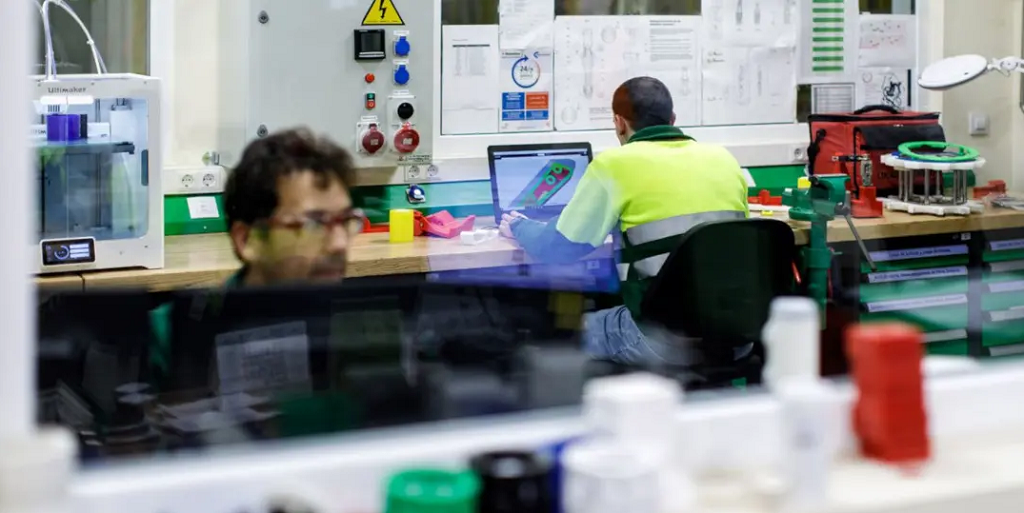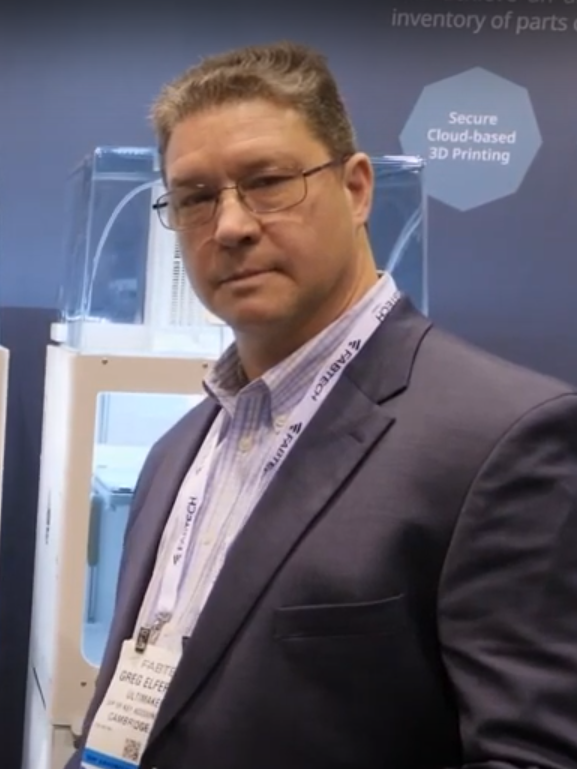
I caught up with Gregory Elfering, President of Ultimaker Americas, for a discussion of Ultimaker’s 2020 reflections and 2021 trends and predictions.
Elfering joined Ultimaker about two years ago, and in January stepped up to lead the Americas arm of the business. He’s been in the 3D printing industry for close to 15 years now, including a long stint at 3D Systems. Now, he’s leading Netherlands-based Ultimaker in growth on this side of the pond. With 16 employees and growing, the business has a “good logistics setup”, manufacturing 3D printers designed in the Netherlands for a ‘made in the USA’ product. The base in Memphis, Tennessee works well, as the city is “a good location for logistics.”
Ultimaker In 2020
As 2020 winds to a close, it was a nice conversation in that it reminded me this year truly hasn’t been all bad. Indeed, for Ultimaker the year was — dare we use the word this year — successful.
“2020 started out great, when the world was normal,” Elfering began. “Even at the beginning of the crisis for us; there was demand for 3D printers, it was clear early on they would be a bridge for PPE.”
Homegrown efforts such as making face shields and ear savers were in evidence everywhere 3D printers were located. And for a company that makes 3D printers, that type of quick demand uptick is also good business.
“You really saw 3D printing just putting a lot of safety equipment, PPE, in the hands of people at the point they needed it. That gave us a bump in the first year,” he said.
Ultimaker saw over 30% growth in the US in the first half of 2020. Much of the 3D printing industry observed an acceleration of adoption, and Elfering pointed out that for Ultimaker a big boost in their acceleration was toward “a trend we call the digital library.”
While we talk often about the concept of the digital warehouse, the designs stored in that “warehouse” have to come from somewhere. Hence, a digital library. As companies engineer parts to be 3D printed, they can store these designs and share them throughout their locations. As companies like Heineken adopt 3D printing in their operations, a vetted design can be 3D printed where it’s needed at another Heineken factory.
“We’re seeing a lot of adoption in food. These companies are quite busy during this pandemic; the world has not slowed down for them. Logistically, it’s tough when spare parts are needed, and that equals downtime. The real breakthrough was this concept of the digital library. Companies are realizing that parts designed at one factory can be 3D printed at another factory. It’s not just a CAD file that someone with very little 3D printing experience whipped up, but you can get a functionally good part, actually developed with GCODE and the settings to make a good part. That part then goes on a platform we call the digital library. For digital manufacturing, it makes it more available for more and more of our customers. Beyond just a fad, it’s starting to become an important business segment,” Elfering said.
The pandemic has accelerated what he names as Ultimaker’s mission: distributed 3D printing.
Ultimaker Essentials
One of the biggest Ultimaker launches this year was the new Ultimaker Essentials.
The launch, as it turns out, is so important it gets its own spotlight at the intersection of 2020 into 2021. Ultimaker Cura is one of the most popular software solutions out there in 3D printing. Updates are eagerly anticipated by its many users. It’s an easy, user-friendly software solution that slices models and “does the technical stuff in the background,” as Elfering notes. So why would someone pay for a subscription to Ultimaker Essentials?
There are a couple of big answers here, and they mostly revolve around professional users. Training and security are the biggest headlines here.
For training, Ultimaker is “creating a user journey” to offer “very professional, scalable training at their fingertips.” Ultimaker Essentials creates a training platform for consistent, clear competency development that would be the same for a user in Cleveland as it would be for a user in Eindhoven. In an academic environment, this can also be helpful. An instructor with Ultimaker Essentials can draw from content from Ultimaker Academy to create a curriculum for their students using Ultimaker Cura. They can also take those students through exams, with “a measured way of determining how proficient that class — or that staff, in a business — is at 3D printing.”
For security reasons, the cloud can often be an IT nightmare. Ultimaker Essentials uses two-factor authentication, and every facet of its operations were “white hat tested to be secure,” Elfering explained. “It was engineered to be bulletproof from an IT perspective.” The software follows IT protocols and security requirements, validated by third-party testing.
“We think Essentials really raised the bar when it comes to our customers consistently using the equipment,” Elfering said. Many 3D printers are purchased — and ultimately left to languish, unused or underused by those who simply don’t have the best understanding of how to leverage the technology. 3D printing spare parts, for example, can instead see a 95% utilization, “running day in and day out” when the full team has the right tools at hand to ensure they understand and can operate the equipment.
“It’s a different approach, to give a customer a user journey. It gives a school or corporation assurance they will get productivity out of it, that they will get success. Too many 3D printers are put in a corner and never used. Ultimaker is taking the stance of being user-friendly, giving customers lots of ways to use this technology in repeatable ways,” Elfering said.
Ultimaker In 2021

Looking ahead, 2021 will already see a change for Ultimaker. The company recently announced the forthcoming retirement of CEO Jos Burger and the January start for new CEO Jürgen von Hollen.
“He couldn’t be coming into our business at a more exciting time,” Elfering said of von Hollen. “He has experience in robotics, we have applications in robotics, we’re seeing how customers implement labor savings and production applications using robots. There’s a tremendous amount in common. He’s coming into this at a time when our technology is starting to find its way into more manufacturing applications. Right now, we’re seeing supply chain and mission-critical parts. More and more materials are being requested. You’ll find more FFF technology doing short-run technology. It already is, and that will continue to be a growing part of our business.”
Aside from the new executive structuring, there’s also plenty to look forward to in the new year for Ultimaker. The company will celebrate its tenth anniversary — a milestone that will, by the sounds of it, be marked with some interesting announcements to come.
Among the overarching trends we’ll see in 2021 is sustainability, driven by a younger generation in the workforce and, for Ultimaker, the company’s Dutch heritage. With Europe “maybe a little ahead of the US in this regard,” companies are considering the complete workflow in regard to pollution and carbon footprint. Those younger employees coming into the workplace will also have more rooted familiarity with additive manufacturing. 3D printers will be more of a tool on their toolbelts, and will work “in line with their strategy of running a greener factory,” Elfering noted.
In the coming year, Ultimaker will be introducing new materials and software improvements. Much of the focus for these launches will be centered around that all-important customer journey Elfering had mentioned. The Ultimaker team is “preparing our channel organization to do a higher level of service and support training,” he noted:
“When we launch some new products we’re really prepared to make sure customers can maximize taking advantage of them. We’re following that mantra of making everyone comfortable using that piece of Ultimaker equipment. Everyone can quickly get up to speed on how to take advantage of the Ultimaker ecosystem and break down those barriers.”
Finally, keeping in mind that 3D printing seems to finally, really, be past the hype, the manufacturing focus will stay at the forefront.
“One thing we have recently done is backed up into Cura and created engineering profiles for all the Ultimaker machines,” Elfering said. “We’ve improved the XYZ motion control, enabling stronger parts and/or higher-accuracy parts. You can get exact tolerances, as opposed to looser tolerances. That gets into measuring repeatability between machines, build-to-build. This is something a customer can select in Cura. We’re starting to see manufacturing materials, and customers want this high-accuracy profile adopted. This tells us they’re looking at these for bridge manufacturing operations, they want to use a printer as a digital tool.”
In 2021, Ultimaker will also be “trying to stretch its software even further,” he added. “We want software to become a revenue-generating part of our business.” This will be done not by hiding everything behind a paywall and taking away free Cura use, but by building up more subscription-based offerings: training, security, intranet sharing within a global organization.
“2021 is a chance for us to prove that a 3D printer belongs in every factory’s shop,” Elfering said.
Via Ultimaker
